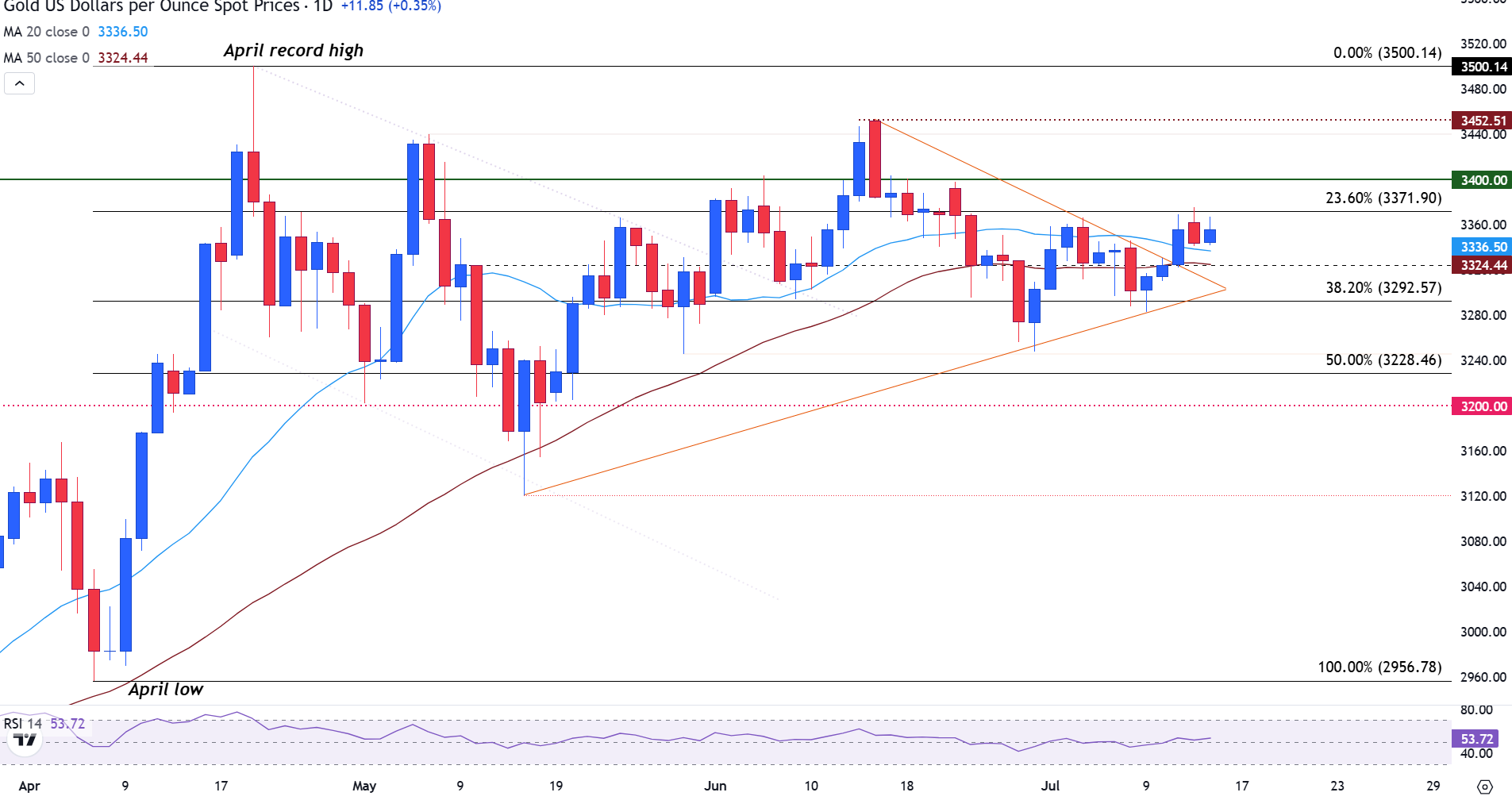- Gold holds around $3,350 as markets await US CPI; inflation risks tied to tariffs in focus.
- The Fed’s interest rate outlook hinges on the June CPI. Headline inflation is expected at 2.7% (YoY) with core CPI estimated at 3.0%.
- XAU/USD technical breakout is looming above $3,371, with support near $3,337.
Gold (XAU/USD) is holding firm, trading slightly higher in the European session on Tuesday, with buyers stepping in ahead of key US inflation data as tariff concerns resurface.
The precious metal bounces back from Monday’s dip and is trading above $3,350 at the time of writing. Focus now shifts to the US Consumer Price Index (CPI) release for June at 12:30 GMT, a major short-term catalyst for price action.
Markets are closely watching CPI data for signs that tariff-driven cost pressures are being passed on to consumers.
Economists are forecasting the annual headline CPI figure for June to rise 2.7%, up from 2.4%. The core CPI, which excludes food and energy prices, is expected to print at 3%, up from 2.8%.
These figures matter because inflation that runs hot could force the Federal Reserve (Fed) to delay interest rate cuts, which would help raise the demand for US yields.
A stronger US Dollar (USD) in response to rising yields could limit the short-term upside potential for XAU/USD. However, expectations persist that persistent inflation will increase the likelihood of the economy slowing at a faster pace. Since inflation reduces the purchasing power of a currency, Gold is often seen as a hedge against such risks, which may help limit the downside move.
Gold daily digest: Trade tensions, tariff risks, and price pressures drive XAU/USD price action
- According to the CME FedWatch Tool, analysts expect the Fed to hold interest rates steady within the 4.25% to 4.50% range in July. The probability of a September rate cut is currently at 59.3%, which may change in response to the US inflation data.
- Additional catalysts for Gold on Tuesday include developments in bilateral relations. As the August 1 tariff deadline approaches, the increase in levies on US imports could further support demand for safe-haven assets, including precious metals. In contrast, easing trade tensions and improved risk sentiment could weigh on XAU/USD price action.
- After US President Donald Trump announced that tariffs on EU imports to the US will be set at 30% on Saturday, an official statement was published on the European Commission’s press corner on Sunday, which read, “We remain ready to continue working towards an agreement by August 1. At the same time, we will take all necessary steps to safeguard EU interests, including the adoption of proportionate countermeasures if required.”
- On Friday, President Trump announced that Mexico will also face a 30% levy on imports to the US. A letter to Mexican President Claudia Sheinbaum, posted on Truth Social read: “Despite our strong relationship, you will recall, the United States imposed Tariffs on Mexico to deal with our Nation’s Fentanyl crisis, which is caused, in part, by Mexico’s failure to stop the Cartels, who are made up of the most despicable people who ever walked the Earth, from pouring these drugs into our country,”
- In a press conference on Monday, President Sheinbaum responded, stating that “If the United States government and its agencies wanted to address the serious consumption of fentanyl in their country, they could combat the sale of narcotics on the streets of their main cities, which they don’t do”.
- The wave of trade threats, especially from the US, Mexico, and the EU, adds a layer of political uncertainty that supports safe-haven demand in Gold. Traders may continue buying dips in XAU/USD not just on soft economic data, but also on signs of deteriorating diplomacy, particularly if rhetoric escalates ahead of August 1 deadline.
Gold technical analysis: XAU/USD holds above $3,350 with $3,400 in sight
Gold is holding above $3,350 at the time of writing, with the 20-day Simple Moving Average (SMA) providing immediate support near $3,337. Below that level, the next supports to look out for are the 50-day Simple Moving Average (SMA) around $3,324 and the $3,300 psychological level.
Price action has broken out of a tightening triangle formation, hinting at a bullish outlook ahead, although confirmation is needed above the $3,371, which aligns with the 23.6% Fibonacci retracement of the April low-high range.

Gold (XAU/USD) daily chart
A clean move through $3,400 could open the door toward the June high of $3,452 and a potential retest of the record high at $3,500.
Meanwhile, the daily Relative Strength Index (RSI) is currently around 55, suggesting that bullish momentum has room to run without being overbought.
Economic Indicator
Consumer Price Index ex Food & Energy (YoY)
Inflationary or deflationary tendencies are measured by periodically summing the prices of a basket of representative goods and services and presenting the data as the Consumer Price Index (CPI). CPI data is compiled on a monthly basis and released by the US Department of Labor Statistics. The YoY reading compares the prices of goods in the reference month to the same month a year earlier. The CPI Ex Food & Energy excludes the so-called more volatile food and energy components to give a more accurate measurement of price pressures. Generally speaking, a high reading is bullish for the US Dollar (USD), while a low reading is seen as bearish.
Read more.
Gold FAQs
Gold has played a key role in human’s history as it has been widely used as a store of value and medium of exchange. Currently, apart from its shine and usage for jewelry, the precious metal is widely seen as a safe-haven asset, meaning that it is considered a good investment during turbulent times. Gold is also widely seen as a hedge against inflation and against depreciating currencies as it doesn’t rely on any specific issuer or government.
Central banks are the biggest Gold holders. In their aim to support their currencies in turbulent times, central banks tend to diversify their reserves and buy Gold to improve the perceived strength of the economy and the currency. High Gold reserves can be a source of trust for a country’s solvency. Central banks added 1,136 tonnes of Gold worth around $70 billion to their reserves in 2022, according to data from the World Gold Council. This is the highest yearly purchase since records began. Central banks from emerging economies such as China, India and Turkey are quickly increasing their Gold reserves.
Gold has an inverse correlation with the US Dollar and US Treasuries, which are both major reserve and safe-haven assets. When the Dollar depreciates, Gold tends to rise, enabling investors and central banks to diversify their assets in turbulent times. Gold is also inversely correlated with risk assets. A rally in the stock market tends to weaken Gold price, while sell-offs in riskier markets tend to favor the precious metal.
The price can move due to a wide range of factors. Geopolitical instability or fears of a deep recession can quickly make Gold price escalate due to its safe-haven status. As a yield-less asset, Gold tends to rise with lower interest rates, while higher cost of money usually weighs down on the yellow metal. Still, most moves depend on how the US Dollar (USD) behaves as the asset is priced in dollars (XAU/USD). A strong Dollar tends to keep the price of Gold controlled, whereas a weaker Dollar is likely to push Gold prices up.

